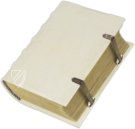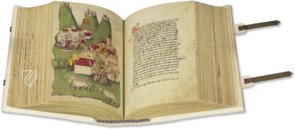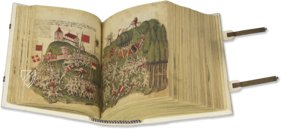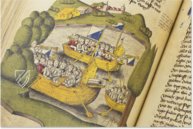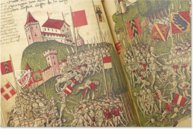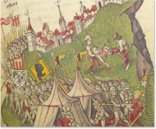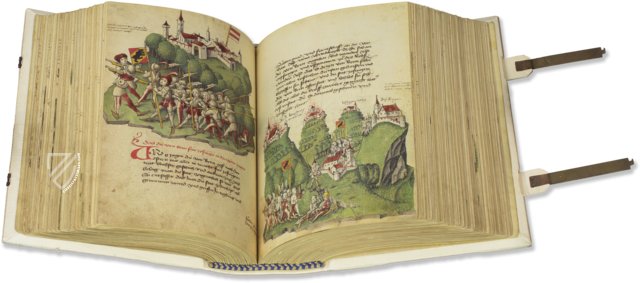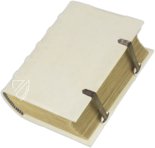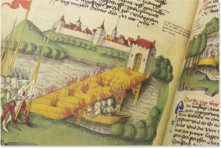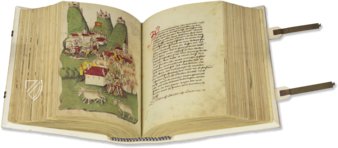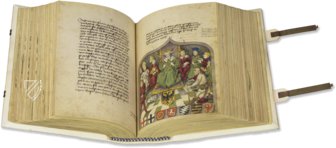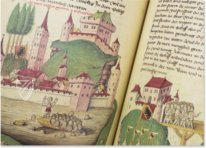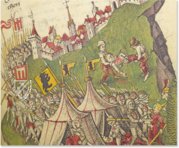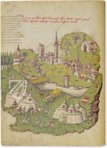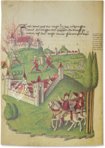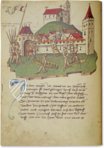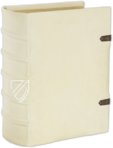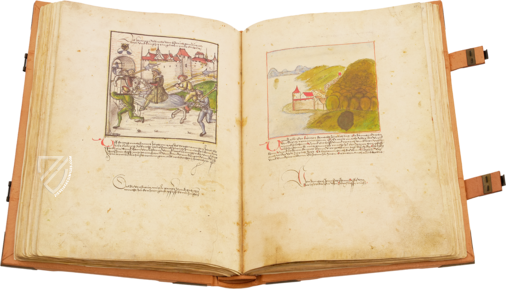Tschachtlan's Illustrated Chronicle
(1,000€ - 3,000€)
Tschachtlan's Illustrated Chronicle is the first illustrated city chronicle in the German language and was created ca. 1470 by the Swiss chronicler Benedict Tschachtlan. Tschachtlan himself designed the 230 mostly full-page, gaily-colored illustrations, which show scenes from the lives of great statesmen, as well as reflecting the everyday life of the common people. With his work, Tschachtlan paved the way for numerous famous successors and contributed to the historical tradition.
Tschachtlan's Illustrated Chronicle
The Swiss Confederation, as it existed in the 15th and 16th centuries, yielded numerous famous names of German book art. Some of the most famous and influential world chronicles originate from this time. The first of these chronicles is Tschachtlan's Illustrated Chronicle. The work created by Benedict Tschachtlan (ca. 1430–93) is a reliable and diverse source for those interested in cultural history. Everyday life in the country and the city as well as events of war in and around the home city of the author, Bern, were chronicled.
The History of the Confederation from 1152 to 1470
Benedict Tschachtlan, a loyal statesman in service to Bern, reports on the events in his beloved city in his chronicle. His claims are based on previous works by Konrad Justinger and Hans Fründ, which until then did not receive much attention. Together with Heinrich Dittinger, his friend and fellow politician in Bern, Tschachtlan created a history of his city, in which he masked everything negative and confined himself solely to the everyday scenes of city life, such as scenes of justice, as well as renowned military actions. Tschachtlan and Dittinger describe themselves as the authors in the epilogue of the work and write that the chronicle ends in 1470.
The Prototype for all Illustrated Chronicles
The chronicle of Tschachtlan is the first work of its kind, never before was a world chronicle illustrated with pictures. As a young man, Diebold Schilling, the most famous Swiss chronicler, made use of Tschachtlan’s book as the foundation for his own first work. One can actually see from it that he was involved in the creation of the codex. Tschachtlan and Dittling did not created their chronicle for a specific commissioner, it was their private work.
The Source of Book Decoration
Tschachtlan himself was responsible for designing the 230 predominantly full-page colored illustrations of the book. The pictures testify to a fresh, unconcerned, and appealing styling. They exhibit an astounding diversity of scenes from life in medieval Bern, for example, weapons and common clothes can be seen, battles and sieges are visible, and the camp life of the soldiers of Bern were illustrated as well. The life of the great statesmen and common peasantry is recorded in the finest detail, the pictures show cities, castles, and above all else the successful campaigns and conquests in those days were painted by the artists in the most magnificent range of colors and detail. Thus the work continues to succeed as a contemporary witness in fascinating the reader to this day.
Codicology
- Alternative Titles
- Tschachtlans Bilderchronik
- Size / Format
- 1,060 pages / 29.8 × 22.0 cm
- Origin
- Switzerland
- Date
- 1470
- Epochs
- Style
- Language
- Illustrations
- 230 mostly full-page coloured illustrations
- Artist / School
- Benedict Tschachtlan (1420–1493)
Tschachtlan's Illustrated Chronicle
Storming a Walled Town
Scaling ladders are assembled and a gate is being hacked apart with an axe as the soldiers of the Prince-Bishop of Basel storm a walled town, which appears undefended and caught by surprise. They are identifiable thanks to the unique standard with the so-called Baslerstab or “Basel Staff” – a red crozier or bishop’s staff with three points on a field of white. The soldiers are fully armored from head to toe, some with open-faced helmets while the faces of others are obscured by their visors.
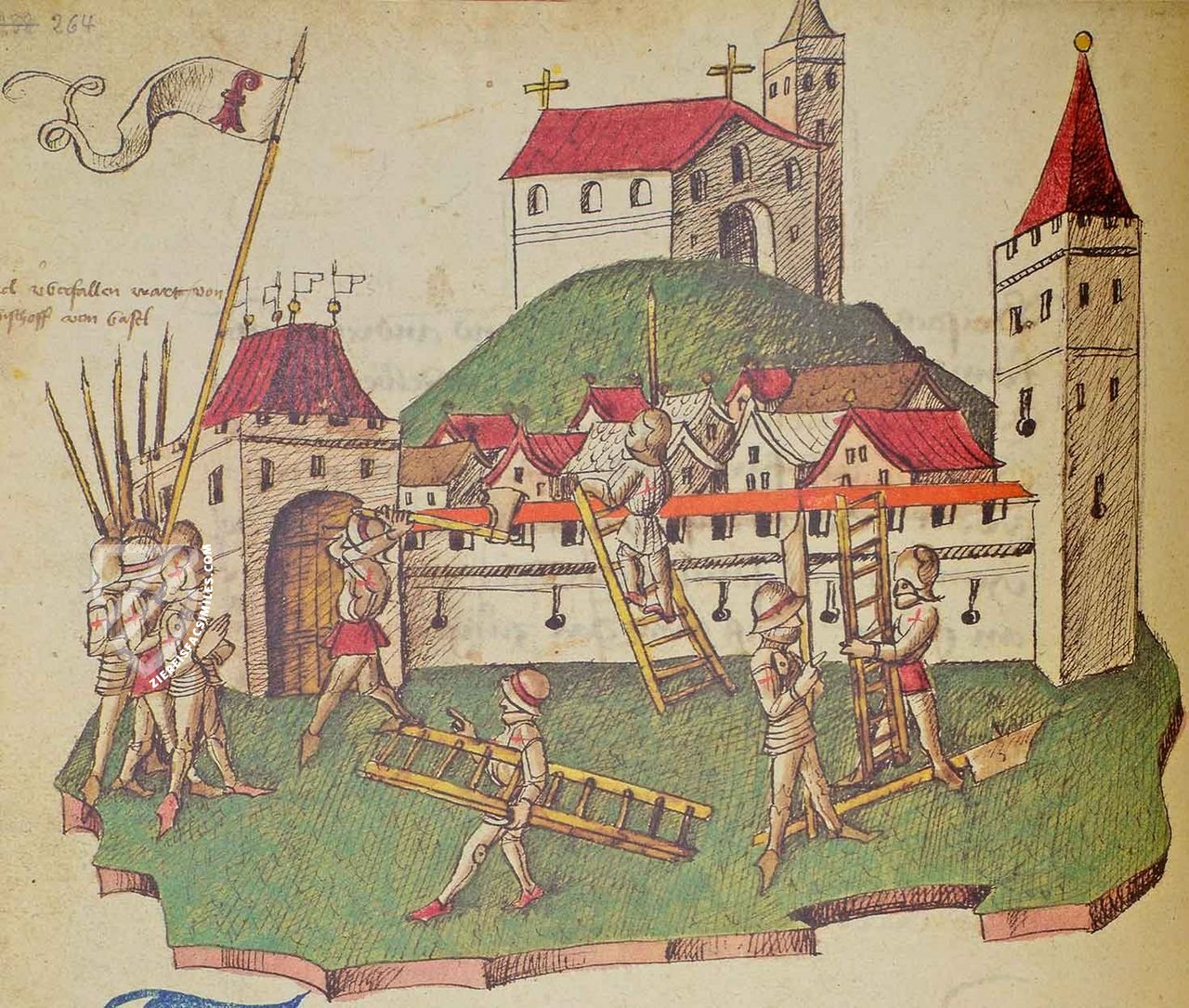
Tschachtlan's Illustrated Chronicle
Conquest of the City of Aarau
On April 18th, 1415, the Hapsburg city of Arrau in Northern Switzerland was attacked by a vast army of Bernese troops equipped with a large caliber cannon, the so-called Nürnberger Büchse. By April 20th, the vastly outmatched defenders had been forced to surrender after a hole was punched in their city wall by the frightening new weapon.
The attackers, identifiable by the bear escutcheon of Bern, and their allies from Solothurn are simultaneously bombarding the city and assaulting the wall by boat. Below the flag of the Hapsburg eagle, one sees a hole punched in the wall and opposite it, Bernese troops armed with pikes are forming up for an attack. The details of late medieval warfare pictured include halberds, Gothic armor, and a catapult.
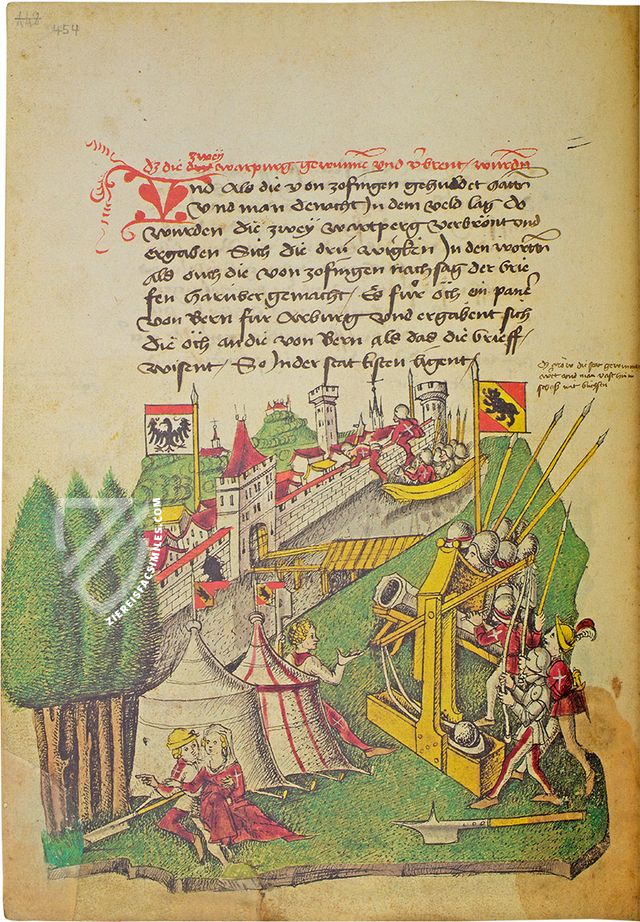
#1 Tschachtlans Bilderchronik
Language: German
(1,000€ - 3,000€)
- Treatises / Secular Books
- Apocalypses / Beatus
- Astronomy / Astrology
- Bestiaries
- Bibles / Gospels
- Chronicles / History / Law
- Geography / Maps
- Saints' Lives
- Islam / Oriental
- Judaism / Hebrew
- Single Leaf Collections
- Leonardo da Vinci
- Literature / Poetry
- Liturgical Manuscripts
- Medicine / Botany / Alchemy
- Music
- Mythology / Prophecies
- Psalters
- Other Religious Books
- Games / Hunting
- Private Devotion Books
- Other Genres
- Afghanistan
- Armenia
- Austria
- Belgium
- Colombia
- Croatia
- Cyprus
- Czech Republic
- Denmark
- Egypt
- Ethiopia
- France
- Germany
- Greece
- Hungary
- India
- Iran
- Iraq
- Israel
- Italy
- Japan
- Lebanon
- Luxembourg
- Mexico
- Morocco
- Netherlands
- Palestine
- Peru
- Poland
- Portugal
- Russia
- Serbia
- Spain
- Sri Lanka
- Sweden
- Switzerland
- Syria
- Turkey
- Ukraine
- United Kingdom
- United States
- Uzbekistan
- Aboca Museum
- Ajuntament de Valencia
- Akademie Verlag
- Akademische Druck- u. Verlagsanstalt (ADEVA)
- Aldo Ausilio Editore - Bottega d’Erasmo
- Alecto Historical Editions
- Alkuin Verlag
- Almqvist & Wiksell
- Amilcare Pizzi
- Andreas & Andreas Verlagsbuchhandlung
- Archa 90
- Archiv Verlag
- Archivi Edizioni
- Arnold Verlag
- ARS
- Ars Magna
- ArtCodex
- AyN Ediciones
- Azimuth Editions
- Badenia Verlag
- Bärenreiter-Verlag
- Belser Verlag
- Belser Verlag / WK Wertkontor
- Benziger Verlag
- Bernardinum Wydawnictwo
- BiblioGemma
- Biblioteca Apostolica Vaticana (Vaticanstadt, Vaticanstadt)
- Bibliotheca Palatina Faksimile Verlag
- Bibliotheca Rara
- Boydell & Brewer
- Bramante Edizioni
- Bredius Genootschap
- Brepols Publishers
- British Library
- C. Weckesser
- Caixa Catalunya
- Canesi
- CAPSA, Ars Scriptoria
- Caratzas Brothers, Publishers
- Carus Verlag
- Casamassima Libri
- Chavane Verlag
- Christian Brandstätter Verlag
- Circulo Cientifico
- Club Bibliófilo Versol
- Club du Livre
- CM Editores
- Collegium Graphicum
- Collezione Apocrifa Da Vinci
- Comissão Nacional para as Comemorações dos Descobrimentos Portugueses
- Coron Verlag
- Corvina
- CTHS
- D. S. Brewer
- Damon
- De Agostini/UTET
- De Nederlandsche Boekhandel
- De Schutter
- Deuschle & Stemmle
- Deutscher Verlag für Kunstwissenschaft
- DIAMM
- Droz
- E. Schreiber Graphische Kunstanstalten
- Ediciones Boreal
- Ediciones Grial
- Ediclube
- Edições Inapa
- Edilan
- Editalia
- Edition Deuschle
- Edition Georg Popp
- Edition Leipzig
- Edition Libri Illustri
- Editiones Reales Sitios S. L.
- Éditions de l'Oiseau Lyre
- Editions Medicina Rara
- Editorial Casariego
- Editorial Mintzoa
- Editrice Antenore
- Editrice Velar
- Edizioni Edison
- Egeria, S.L.
- Eikon Editores
- Electa
- Emery Walker Limited
- Enciclopèdia Catalana
- Eos-Verlag
- Ephesus Publishing
- Ernst Battenberg
- Eugrammia Press
- Extraordinary Editions
- Fackelverlag
- Facsimila Art & Edition
- Facsimile Editions Ltd.
- Facsimilia Art & Edition Ebert KG
- Faksimile Verlag
- Feuermann Verlag
- Folger Shakespeare Library
- Franco Cosimo Panini Editore
- Friedrich Wittig Verlag
- Fundación Hullera Vasco-Leonesa
- G. Braziller
- Gabriele Mazzotta Editore
- Gebr. Mann Verlag
- Gesellschaft für graphische Industrie
- Getty Research Institute
- Giovanni Domenico de Rossi
- Giunti Editore
- Graffiti
- Grafica European Center of Fine Arts
- Guido Pressler
- Guillermo Blazquez
- Gustav Kiepenheuer
- H. N. Abrams
- Harrassowitz
- Helikon
- Hendrickson Publishers
- Henning Oppermann
- Herder Verlag
- Hes & De Graaf Publishers
- Hoepli
- Holbein-Verlag
- Hortus Deliciarum
- Houghton Library
- Hugo Schmidt Verlag
- Idion Verlag
- Il Bulino, edizioni d'arte
- ILte
- Imago
- Insel Verlag
- Instituto Nacional de Antropología e Historia
- Istituto dell'Enciclopedia Italiana - Treccani
- Istituto Ellenico di Studi Bizantini e Postbizantini
- Istituto Geografico De Agostini
- Istituto Poligrafico e Zecca dello Stato
- Italarte Art Establishments
- J. Thorbecke
- Jan Thorbecke Verlag
- Johnson Reprint Corporation
- Josef Stocker
- Josef Stocker-Schmid
- Jugoslavija
- Karl W. Hiersemann
- Kasper Straube
- Kaydeda Ediciones
- Kindler Verlag / Coron Verlag
- Kodansha International Ltd.
- Konrad Kölbl Verlag
- Kurt Wolff Verlag
- La Liberia dello Stato
- La Linea Editrice
- La Meta Editore
- Lambert Schneider
- Landeskreditbank Baden-Württemberg
- Leo S. Olschki
- Les Incunables
- Library of Congress
- Libreria Musicale Italiana
- Lichtdruck
- Lito Immagine Editore
- Lumen Artis
- Lund Humphries
- M. Moleiro Editor
- Maison des Sciences de l'homme et de la société de Poitiers
- Manuscriptum
- Martinus Nijhoff
- Maruzen-Yushodo Co. Ltd.
- MASA
- McGraw-Hill
- Militos
- Millennium Liber
- Müller & Schindler
- Nahar and Steimatzky
- National Library of Wales
- Neri Pozza
- Nova Charta
- Oceanum Verlag
- Odeon
- Orbis Mediaevalis
- Orbis Pictus
- Österreichische Staatsdruckerei
- Oxford University Press
- Pageant Books
- Parzellers Buchverlag
- Patrimonio Ediciones
- Pattloch Verlag
- PIAF
- Pieper Verlag
- Plon-Nourrit et cie
- Prestel Verlag
- Princeton University Press
- Prisma Verlag
- Priuli & Verlucca, editori
- Pro Sport Verlag
- Propyläen Verlag
- Pytheas Books
- Quaternio Verlag Luzern
- Reales Sitios
- Recht-Verlag
- Reichert Verlag
- Reichsdruckerei
- Riehn & Reusch
- Roberto Vattori Editore
- Rosenkilde and Bagger
- Roxburghe Club
- Salerno Editrice
- Sarajevo Svjetlost
- Schöck ArtPrint Kft.
- Scolar Press
- Scrinium
- Scripta Maneant
- Scriptorium
- Siloé, arte y bibliofilia
- SISMEL - Edizioni del Galluzzo
- Sociedad Mexicana de Antropología
- Société des Bibliophiles & Iconophiles de Belgique
- Soncin Publishing
- Sorli Ediciones
- Stainer and Bell
- Studer
- Styria Verlag
- Sumptibus Pragopress
- Szegedi Tudomànyegyetem
- Taberna Libraria
- Tarshish Books
- Taschen
- Tempus Libri
- Testimonio Compañía Editorial
- Thames and Hudson
- The Clear Vue Publishing Partnership Limited
- The Facsimile Codex
- The Folio Society
- The Marquess of Normanby
- The Richard III and Yorkist History Trust
- Tip.Le.Co
- TouchArt
- TREC Publishing House
- TRI Publishing Co.
- Trident Editore
- Typis Regiae Officinae Polygraphicae
- Union Verlag Berlin
- Universidad de Granada
- University of California Press
- University of Chicago Press
- Urs Graf
- Vallecchi
- Van Wijnen
- VCH, Acta Humaniora
- VDI Verlag
- VEB Deutscher Verlag für Musik
- Verlag Anton Pustet / Andreas Verlag
- Verlag Bibliophile Drucke Josef Stocker
- Verlag der Münchner Drucke
- Verlag für Regionalgeschichte
- Verlag Styria
- Vicent Garcia Editores
- W. Turnowsky
- Waanders Printers
- Wiener Mechitharisten-Congregation (Wien, Österreich)
- Wissenschaftliche Buchgesellschaft
- Wydawnictwo Dolnoslaskie
- Xuntanza Editorial
- Zakład Narodowy
- Zollikofer AG





